View in other NatureServe Network Field Guides
NatureServe
Montana
Utah
Wyoming
Idaho
Wisconsin
British Columbia
South Carolina
Yukon
California
New York
Meadow Larkspur - Delphinium burkei
Other Names:
[including] Delphinium distichum
State Rank Reason (see State Rank above)
Only known from a few collections from the western half of the state.
General Description
Meadow larkspur is a perennial herb with non-hollow stems, 4-7 dm (16-28 in) high, from a cluster of short, tuberous roots. The long-stalked basal leaves, 4-6 cm (ca. 2 in) wide, are hemispheric in outline and twice divided like the fingers on a hand into broad, rounded lobes. The numerous leaves of the upper stem are once deeply divided into linear segments. Foliage is covered with fine, short, white hairs. Flowers are well separated in a spike at the top of the stem; lower flowers are stalked, while the upper are not. Each flower has 5 blue petal-like sepals, 7-9 mm long, projecting forward. The upper one has a conical spur, 11-17 mm long, projecting back. The 2 lower petals are blue and longer than the sepals, while the 2 upper petals are white and shorter. The fruit is an erect, hairy, oblong, 3-lobed capsule, 8-12 mm long.
Phenology
Flowering in July.
Diagnostic Characteristics
Easily confused with D. depauperatum, which is usually shorter, less hairy, with fewer, but larger flowers and sepals usually darker. Also, D. depauperatum has fewer stem leaves. Leaf dimorphy is also expressed in D. depauperatum, just to a lesser degree. The leaves of D. depauperatum are usually less deeply divided or have broader leaf lobes. Both grow in moist meadows, but D. burkei tends to prefer meadows that fully desiccate in summer.
Species Range
Montana Range
Range Descriptions
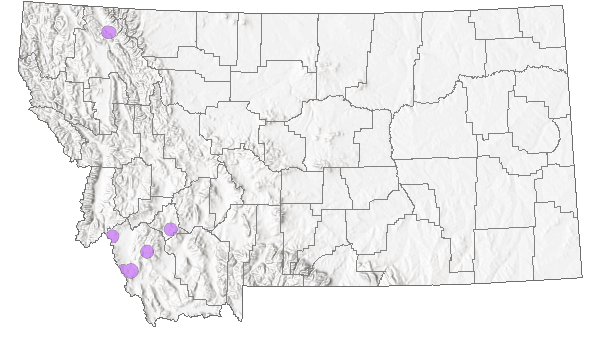
 Native
Native
Range Comments
BC to OR, east to ID, and MT (Lesica et al. 2012. Manual of Montana Vascular Plants. BRIT Press. Fort Worth, TX).
Observations in Montana Natural Heritage Program Database
Number of Observations: 9
(Click on the following maps and charts to see full sized version)
Map Help and Descriptions
Relative Density
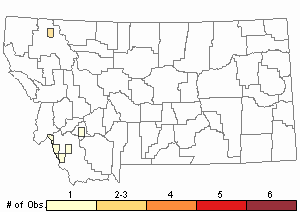
Recency
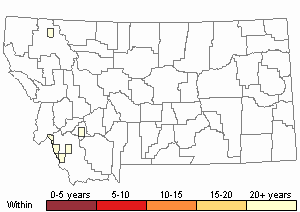
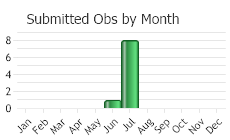
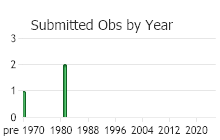 (Observations spanning multiple months or years are excluded from time charts)
(Observations spanning multiple months or years are excluded from time charts)
Habitat
Moist meadows in the valley and lower montane zone. Usually where soils are saturated in spring, desiccated in summer.
National Vegetation Classification System Groups Associated with this Species
Grassland
Montane - Subalpine Grassland
Wetland and Riparian
Wet Meadow and Marsh
Ecology
POLLINATORS The following animal species have been reported as pollinators of this plant species or its genus where their geographic ranges overlap:
Bombus vagans,
Bombus appositus,
Bombus auricomus,
Bombus borealis,
Bombus centralis,
Bombus fervidus,
Bombus flavifrons,
Bombus mixtus,
Bombus occidentalis,
Bombus pensylvanicus,
Bombus griseocollis,
Bombus impatiens, and
Bombus kirbiellus (Plath 1934, Macior 1974, Bauer 1983, Thorp et al. 1983, Wilson et al. 2010, Colla and Dumesh 2010, Koch et al. 2012, Pyke et al. 2012, Miller-Struttmann and Galen 2014, Williams et al. 2014).
Stewardship Responsibility
Threats or Limiting Factors
STATE THREAT SCORE REASON
Threat impact not assigned because threats are not known (MTNHP Threat Assessment 2021).
References
- Literature Cited AboveLegend:
 View Online Publication
View Online Publication Bauer, P.J. 1983. Bumblebee pollination relationships on the Beartooth Plateau tundra of Southern Montana. American Journal of Botany. 70(1): 134-144.
Bauer, P.J. 1983. Bumblebee pollination relationships on the Beartooth Plateau tundra of Southern Montana. American Journal of Botany. 70(1): 134-144. Colla, S.R. and S. Dumesh. 2010. The bumble bees of southern Ontario: notes on natural history and distribution. Journal of the Entomological Society of Ontario 141:39-68.
Colla, S.R. and S. Dumesh. 2010. The bumble bees of southern Ontario: notes on natural history and distribution. Journal of the Entomological Society of Ontario 141:39-68. Koch, J., J. Strange, and P. Williams. 2012. Bumble bees of the western United States. Washington, DC: USDA Forest Service, Pollinator Partnership. 143 p.
Koch, J., J. Strange, and P. Williams. 2012. Bumble bees of the western United States. Washington, DC: USDA Forest Service, Pollinator Partnership. 143 p. Lesica, P., M.T. Lavin, and P.F. Stickney. 2012. Manual of Montana Vascular Plants. Fort Worth, TX: BRIT Press. viii + 771 p.
Lesica, P., M.T. Lavin, and P.F. Stickney. 2012. Manual of Montana Vascular Plants. Fort Worth, TX: BRIT Press. viii + 771 p. Macior, L.M. 1974. Pollination ecology of the Front Range of the Colorado Rocky Mountains. Melanderia 15: 1-59.
Macior, L.M. 1974. Pollination ecology of the Front Range of the Colorado Rocky Mountains. Melanderia 15: 1-59. Miller-Struttmann, N.E. and C. Galen. 2014. High-altitude multi-taskers: bumble bee food plant use broadens along an altitudinal productivity gradient. Oecologia 176:1033-1045.
Miller-Struttmann, N.E. and C. Galen. 2014. High-altitude multi-taskers: bumble bee food plant use broadens along an altitudinal productivity gradient. Oecologia 176:1033-1045. MTNHP Threat Assessment. 2021. State Threat Score Assignment and Assessment of Reported Threats from 2006 to 2021 for State-listed Vascular Plants. Botany Program, Montana Natural Heritage Program, Helena, Montana.
MTNHP Threat Assessment. 2021. State Threat Score Assignment and Assessment of Reported Threats from 2006 to 2021 for State-listed Vascular Plants. Botany Program, Montana Natural Heritage Program, Helena, Montana. Plath, O.E. 1934. Bumblebees and their ways. New York, NY: Macmillan Company. 201 p.
Plath, O.E. 1934. Bumblebees and their ways. New York, NY: Macmillan Company. 201 p. Pyke, G.H., D.W. Inouye, and J.D. Thomson. 2012. Local geographic distributions of bumble bees near Crested Butte, Colorado: competition and community structure revisited. Environmental Entomology 41(6): 1332-1349.
Pyke, G.H., D.W. Inouye, and J.D. Thomson. 2012. Local geographic distributions of bumble bees near Crested Butte, Colorado: competition and community structure revisited. Environmental Entomology 41(6): 1332-1349. Thorp, R.W., D.S. Horning, and L.L. Dunning. 1983. Bumble bees and cuckoo bumble bees of California (Hymenoptera: Apidae). Bulletin of the California Insect Survey 23:1-79.
Thorp, R.W., D.S. Horning, and L.L. Dunning. 1983. Bumble bees and cuckoo bumble bees of California (Hymenoptera: Apidae). Bulletin of the California Insect Survey 23:1-79. Williams, P., R. Thorp, L. Richardson, and S. Colla. 2014. Bumble Bees of North America. Princeton, NJ: Princeton University Press. 208 p.
Williams, P., R. Thorp, L. Richardson, and S. Colla. 2014. Bumble Bees of North America. Princeton, NJ: Princeton University Press. 208 p. Wilson, J.S., L.E. Wilson, L.D. Loftis, and T. Griswold. 2010. The montane bee fauna of north central Washington, USA, with floral associations. Western North American Naturalist 70(2): 198-207.
Wilson, J.S., L.E. Wilson, L.D. Loftis, and T. Griswold. 2010. The montane bee fauna of north central Washington, USA, with floral associations. Western North American Naturalist 70(2): 198-207.
- Additional ReferencesLegend:
 View Online Publication
View Online Publication
Do you know of a citation we're missing? Ewan, J. 1945. A synopsis of the North American species of Delphinium. University of Colorado Studies 2(2):55-242.
Ewan, J. 1945. A synopsis of the North American species of Delphinium. University of Colorado Studies 2(2):55-242. Lesica, P., M.T. Lavin, and P.F. Stickney. 2022. Manual of Montana Vascular Plants, Second Edition. Fort Worth, TX: BRIT Press. viii + 779 p.
Lesica, P., M.T. Lavin, and P.F. Stickney. 2022. Manual of Montana Vascular Plants, Second Edition. Fort Worth, TX: BRIT Press. viii + 779 p. Sawyer, P.T. 1967. Biosystematic studies of species of delphinium occurring in Montana. M.Sc. Thesis. Bozeman, MT: Montana State University. 56 p.
Sawyer, P.T. 1967. Biosystematic studies of species of delphinium occurring in Montana. M.Sc. Thesis. Bozeman, MT: Montana State University. 56 p. Sawyer, P.T. 1970. Systematic studies of non-fistulose delphinium taxa common to Montana. Ph.D. Dissertation. Bozeman, MT: Montana State University. 84 p.
Sawyer, P.T. 1970. Systematic studies of non-fistulose delphinium taxa common to Montana. Ph.D. Dissertation. Bozeman, MT: Montana State University. 84 p. Taylor, R.J. 1960. The genus Delphinium in Wyoming. University of Wyoming publications 24:9-21.
Taylor, R.J. 1960. The genus Delphinium in Wyoming. University of Wyoming publications 24:9-21.
- Web Search Engines for Articles on "Meadow Larkspur"





